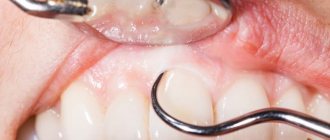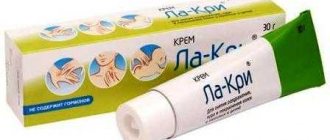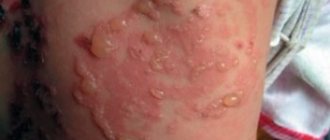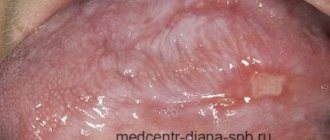Are you familiar with the feeling of burning and itching on your lips? Or the unexpected appearance of bubbles on the skin of the face and lips? 95% of the people on the planet know what I'm talking about. True, not everyone pays due attention to these things. Let's start with the fact that any inflammation of the oral mucosa is called STOMATITIS. But in this article we will talk about the most common disease in the world as a whole, popularly called HERPES. Namely, we will consider herpetic stomatitis, etiology, pathogenesis, clinic and treatment of this disease.
It's all the virus's fault!
The term "stomatitis" is derived from the merger of two Greek words: stoma (mouth) and itis (inflammation). There are a great variety of different types of disease - serous, aphthous, allergic, etc. The most dangerous is herpetic, or cold sore, stomatitis caused by a virus. Its main manifestations are painful ulcers covering the oral mucosa. The trigger mechanism of the disease is the activation of herpes simplex virus types 1 and 2. First of all, the disease threatens those who have a weakened immune system and, as a result, the body simply does not have the strength to give a worthy rebuff to viruses.
Prevention of stomatitis
You can avoid any form of the disease if you follow a few tips from dentists:
- Chew food thoroughly and slowly - the slightest wound after biting will provoke the appearance of multiple ulcers.
- Do not brush your teeth with a brush that is too hard; it is better to choose medium-hard bristles. At your doctor’s appointment, ask which type of toothpaste is best for you individually.
- Maintain hygiene – cleaning should not be limited to morning and evening. If you cannot use a toothbrush, rinse your mouth with warm water at room temperature after each meal. Ideally, buy a compact irrigator.
- For smokers, reduce the number of cigarettes per day, or give up the bad habit forever. Tobacco smoke not only harms the mucous membrane, but also promotes the growth of fungus and pathogenic bacteria.
- Balance your diet - drink scalding hot drinks as little as possible, reduce sour, spicy, salty and fatty foods in your diet. Give preference to dairy products, white meat and fresh, thoroughly washed fruits.
- Visit the dentist at least twice a year for a preventive examination.
Forms of the disease
Lightweight
It is considered the most beneficial for the body. In this form, people with high immunity suffer from herpes stomatitis. It flows without temperature. It is distinguished by single rashes that do not cause discomfort and disappear on their own without consequences.
Average
General disorders are added: weakness, drowsiness, fatigue, loss of appetite. Rashes appear in several places at the same time. The temperature rises to 37-37.6°C.
Heavy
This form of stomatitis indicates extremely low immunity. The rashes are multiple and painful. Severe headache, chills, and vomiting appear. The temperature exceeds 38oC.
If the disease is mild, the patient may not notice any external signs!
Classification and diagnosis
Herpetic stomatitis is classified both according to the severity of the disease and the characteristics of its course.
According to the characteristics of the course, acute and chronic (recurrent) forms are distinguished. Acute stomatitis is characterized by a sudden onset, pronounced symptoms, and rapid development. Without proper treatment, it quickly becomes chronic and can drag on for years, periodically exacerbating.
Based on the degree of severity, there are mild, moderate, and severe forms.
In mild forms, the following are noted:
- slight increase in body temperature;
- redness, swelling, inflammation of the gums;
- swollen lymph nodes;
- a small number of painful ulcers.
The average degree is characterized by:
- significant increase in body temperature;
- general weakness, nausea, headache;
- inflammation of the oral mucosa;
- the appearance of a blistering rash on the inner surface of the cheeks, gums, tongue, and around the mouth.
The severe form causes:
- temperature rise to a critical level;
- lymphadenitis of the cervical, submandibular lymph nodes;
- a sharp disturbance in general well-being;
- the appearance of severe muscle pain, headache;
- nausea, vomiting;
- multiple rashes that spread to the eyelids, conjunctiva, and perioral area.
Diagnosing the disease is not difficult for an experienced doctor. It is based on an analysis of the main symptoms, the order of clinical manifestations of the disease, the nature, and multiplicity of ulcers.
It is necessary to differentiate herpetic stomatitis from viral stomatitis; for this, in the first few days of the disease, a cytological examination of scrapings from erosions and aphthae should be done.
How to distinguish herpes from stomatitis?
Many patients try to find an answer on the Internet to the question: “Do I have stomatitis or herpes? How to recognize? Herpes stomatitis can be easily distinguished from ordinary stomatitis by 3 key signs.
- With herpes infection, the rash is localized in the gum area. Whereas with stomatitis - on the soft tissues of the oral cavity (tongue, cheeks).
- A herpes rash first appears as blisters, which then ulcerate, while stomatitis begins with the appearance of ulcers.
- Herpetic stomatitis is characterized by a stable appearance of the rash in the same places, and with ordinary stomatitis its location often changes.
Herpetic or aphthous?
It will be somewhat more difficult to distinguish between herpetic and aphthous stomatitis. The latter got its name from the Greek term “aftha”, which means “ulcer”.
If with herpetic stomatitis there are many ulcers, but they are small, then with aphthous stomatitis there are few of them, and the size can reach 7–8 mm.
The second important distinguishing feature is the absence of swelling of the gums with aphthous stomatitis.
If you are looking for differences between herpetic and aphthous stomatitis, then the third thing you should pay attention to is the localization of the rash. Aphthous is characterized by the appearance of ulcers in the oral cavity, while herpes infection can spread to the border of the lips.
Symptoms of herpetic stomatitis during exacerbation
With exacerbation of stomatitis, signs of general malaise and intoxication may appear: headache, muscle weakness, high temperature. The main symptoms of the disease occur in the oral cavity:
- the mucous membrane becomes red and inflamed;
- bubbles appear in groups on the red border of the lips, the cheek side, on the gums and tongue;
- after 2-3 days from the onset of the disease, the vesicles open with the formation of erosions covered with fibrinous plaque;
- pain appears, intensifying while chewing food;
- drooling and enlarged cervical lymph nodes may occur;
- the mucous membrane heals in 5-10 days, leaving no scars.
You can see what chronic herpetic stomatitis looks like in the photo - treatment quickly reduces signs of inflammation and leads to the healing of ulcers, but you need to fight first of all with the herpes virus, which regularly worsens against the background of decreased immunity, stress and hypothermia.
How to distinguish herpes sore throat from stomatitis?
Despite the fact that these medical terms have the same grammatical root, herpetic sore throat and herpetic stomatitis are two different diseases. Unlike stomatitis, herpes sore throat occurs not due to the penetration of the herpes virus, but as a result of an adenovirus infection (in particular, the Coxsackie A virus). Children are more likely to suffer from this disease than adults. The rashes are localized, for the most part, on the soft palate and tonsils. Typical symptoms of stomatitis include pain in the abdomen and abnormal bowel movements.
Attention!
The disease begins acutely, with a jump in temperature to 40 degrees, and is severe, so differential diagnosis should only be carried out by a doctor.
Bacterial or viral?
In addition to viral origin, the disease can be caused by bacteria: streptococci and staphylococci are normally present in the microflora of the oral cavity and begin to multiply uncontrollably during the inflammatory process. The latter may be caused by caries or periodontitis (read more about the disease in the article).
How to distinguish viral stomatitis from bacterial one? It is extremely difficult to do this at home, so it is better to consult a doctor. The main differential feature is the localization of the rash. With viral herpetic stomatitis, vesicles with transparent contents first appear on the tongue (its tip, along the side surfaces and under it), and then can even spread to the pharynx and tonsils.
For bacterial stomatitis, the location of the rash on the gums and those areas where the skin borders the mucous membrane (for example, on the red border of the lips) is more common. Also, with a disease caused by streptococci, “jams” are often observed - pustules on the corners of the mouth, which quickly begin to bleed, become covered with a crust, crack and cause constant discomfort while eating and talking.
Types of diagnostics
An experienced doctor can identify herpetic stomatitis in adults during an initial examination, relying on only two methods.
- Clinical picture.
Based on the totality of the patient’s specific complaints and distinctive external signs, the dentist will not only assess the severity of the disease, but also differentiate it from ordinary stomatitis, candidiasis, etc. - Immunofluorescence.
Express microscopy method, the most accurate for diagnosing acute herpetic stomatitis.
How and with what to treat herpetic stomatitis in children
As Dr. Komarovsky notes, treatment of herpetic stomatitis in children, regardless of age, depends on the severity of the disease, the general condition of the patient’s immune system, and the presence or absence of concomitant diseases.
The main question that interests young parents is which doctor should they contact if they suspect herpetic stomatitis. Both a qualified pediatrician and a dentist can advise the child.
Therapeutic methods include both general and local treatment. Common activities include:
- prescription of antiviral drugs (acyclovir, Zovirax, Herpevir, Virolex);
- taking antipyretic and painkillers (paracetamol, Panadol, Eferalgan, Tylenol);
- prescription of antihistamines (diazolin, claritin, erius, fenistil);
- correction of the immune system (immudon, sodium nucleinate);
- vitamin therapy (vitamin C, ascorutin, multivitamins, B vitamins).
Children of older preschool and school age are recommended to be treated with broad-spectrum antibiotics to avoid possible complications.
For newborns and infants, antibiotic therapy is prescribed only as a last resort, with preference given to local therapy:
- applications of painkillers (solution of lidocaine, trimecaine, pyromecaine);
- treating the baby’s oral cavity with antiseptics (solutions of furatsilin, potassium permanganate, brilliant green, blue);
- Treatment of aphthae with iodine should be avoided, as it causes a burn to the mucous membrane;
- the use of antiviral medications in the form of ointments, lotions, solutions (interferon, acyclovir);
- applying an oil solution of vitamin A, sea buckthorn or rosehip oil, solcoseryl to the mucous membrane of the baby’s mouth).
If the symptoms of the disease do not disappear on the 3-4th day of treatment, but only intensify, the child is indicated for treatment in a hospital setting, otherwise stomatitis will become chronic, from which it is impossible to get rid of it.
Causes of herpes stomatitis
There are two types of herpetic stomatitis: acute and chronic. Acute herpetic stomatitis, according to Dr. Komarovsky, occurs only in children under 3 years of age, when for the first time the child’s body, already deprived of antibodies to the herpes virus received from the mother, is first exposed to a viral attack from the outside. Moreover, the source of infection, as a rule, is the parents themselves - carriers of the virus, who kiss the baby or lick his pacifier or feeding spoon.
Recurrent or chronic stomatitis is already the lot of adults. The disease is recurrent in nature as soon as the body’s immune forces are weakened. In this case, primary infection can occur either through airborne droplets (sneezing), or through household contact (for example, through the use of the same dishes with a virus carrier) or hematogenous (through blood during injections, etc.). The incubation period of the disease can last up to two weeks depending on the state of the immune system.
Attention!
The pathogenesis of the disease in dentistry is still unknown. But if the body is weakened, any injury to the palate or gums can provoke activation of the herpes virus types 1 and 2!
Causes
Herpetic stomatitis, or as it is also called aphthous stomatitis, is dangerous, first of all, for young children. It is a serious viral disease, which, in addition to damaging the oral mucosa, causes general intoxication of the body and provokes malfunctions of the nervous, immune, and reticuloendothelial systems.
Herpes, which is the causative agent of the disease, may not make itself felt for a long time, although infection usually occurs in early childhood.
When the baby’s immunity is weakened, the herpes virus is activated and begins to multiply, causing an increase in temperature, enlargement of the submandibular lymph nodes, acute inflammation of the mucous membrane, and the formation of bleeding and painful ulcers on its surface.
Main reasons:
- decreased baby's immunity;
- previous infectious diseases;
- lack of vitamins;
- insufficient oral hygiene;
- direct contact with patients with herpes stomatitis.
Infants are more likely to become infected with the herpes virus during childbirth, provided the mother has a herpes infection. In children under one year old and school-age children, the virus is activated against the background of an organism weakened by disease and vitamin deficiency.
Treatment of herpetic stomatitis
How to treat herpes stomatitis? Unfortunately, the herpes virus, once entered into a person’s blood, remains in a “dormant” state for the rest of his life. But treatment of viral stomatitis is possible provided that you do not delay visiting the dentist when the first signs of the disease are detected. During the period of therapy, in order to avoid infecting loved ones, you should eat and drink from separate containers and avoid kissing. The patient is recommended a diet that excludes spicy, smoked, sour and salty foods, which can irritate the damaged oral mucosa, and an increased drinking regimen (up to 2.5 liters per day), aimed at combating the manifestations of general intoxication of the body.
How long does the disease last and how many days is the child contagious?
Depending on the complexity of the form, herpes stomatitis in children lasts from several days to 2-3 weeks. With a mild form, the main symptoms disappear on the third or fourth day, treatment of a moderate form takes one to two weeks. The severe form is the most dangerous; healing lasts for weeks and requires mandatory hospitalization of the baby.
The disease is characterized by a high degree of contagiousness precisely during the period of exacerbation.
The infection is transmitted by airborne droplets (including through kissing), when using shared dishes, cutlery, toys, and hygiene items.
Herpes is contagious and can easily be transferred to healthy parts of your own body.
It is necessary to wash your hands thoroughly after treating the surface affected by the sores with medications to prevent the spread of the virus.
Drug therapy
Rinse
To stop the spread of infection throughout the oral cavity, as well as to prevent the occurrence of sore throat, anti-inflammatory drugs such as Stomatidine and Miramistin are prescribed. The greatest effect is achieved by repeating the rinsing procedure every 3 hours, strictly adhering to the instructions for medicinal solutions.
Antiviral drugs
To suppress the reproduction of the herpes virus, the patient is advised to take “Immudon” and “Acyclovir” orally according to the scheme, and for external use - “Viferon” ointment or “Silicea” gel.
Vitamin therapy
Tablet vitamin complexes such as “Complivit” help improve immunity.
Attention!
Before use, consultation with a specialist is recommended!
Treatment at home with folk remedies
On the Internet you can often come across the question: “How to treat herpetic stomatitis with folk remedies?” Let’s make a reservation right away: when treating this disease, you cannot rely solely on traditional medicine methods. Therapy must be comprehensive, and only a doctor can choose it correctly.
An effective folk remedy for rinsing the mouth is propolis tincture diluted with boiled water 1:3. In case of pronounced “jams” in the corners of the mouth and painful ulcers inside, applications with natural sea buckthorn oil have an analgesic and wound-healing effect.
Prevention measures
- Strengthening the immune system.
Avoid excessive exercise and stress. Take a multivitamin in the fall and spring. Regular exercise and hardening increase the vitality of the body. - Healthy lifestyle.
Get rid of bad habits: scientists have proven that excessive smoking and alcoholic beverages can become a catalyst for the activation of the herpes virus in the body. - Timely treatment of chronic diseases.
Do not forget that simple stomatitis, if you do not seek medical help in a timely manner, can develop into herpetic stomatitis. Chronic caries and acute respiratory viral diseases suffered “on the legs” also seriously undermine the body’s immune defense. - Maintain personal hygiene.
According to statistics, it is poor oral hygiene that most often opens the way for herpes infection. - Avoid oral trauma.
Even a minor microcrack from a prick with a fish bone or careless use of a toothpick can become an “entry gate” for the herpes virus.
Attention!
With reduced immunity, herpes stomatitis becomes chronic and relapsing: the disease can recur 2-6 months after recovery.
Prevention in children
Preventing infection with the herpes virus is extremely difficult, since 90% of the population are carriers of it. It is important to delay infection as much as possible; the younger the child, the more difficult the disease is to tolerate. It is necessary to avoid contact with people who have an acute herpes virus. From infancy, the baby should be taught to use personal hygiene products, not allowed to drink from someone else’s mug after someone else, or to use used spoons, forks, and plates. You should not kiss someone who has a herpetic sore on their lips.
To prevent herpetic stomatitis, you need to do general strengthening of the child’s immune system, systematically give him B vitamins, multivitamin complexes, and carry out hardening procedures.











